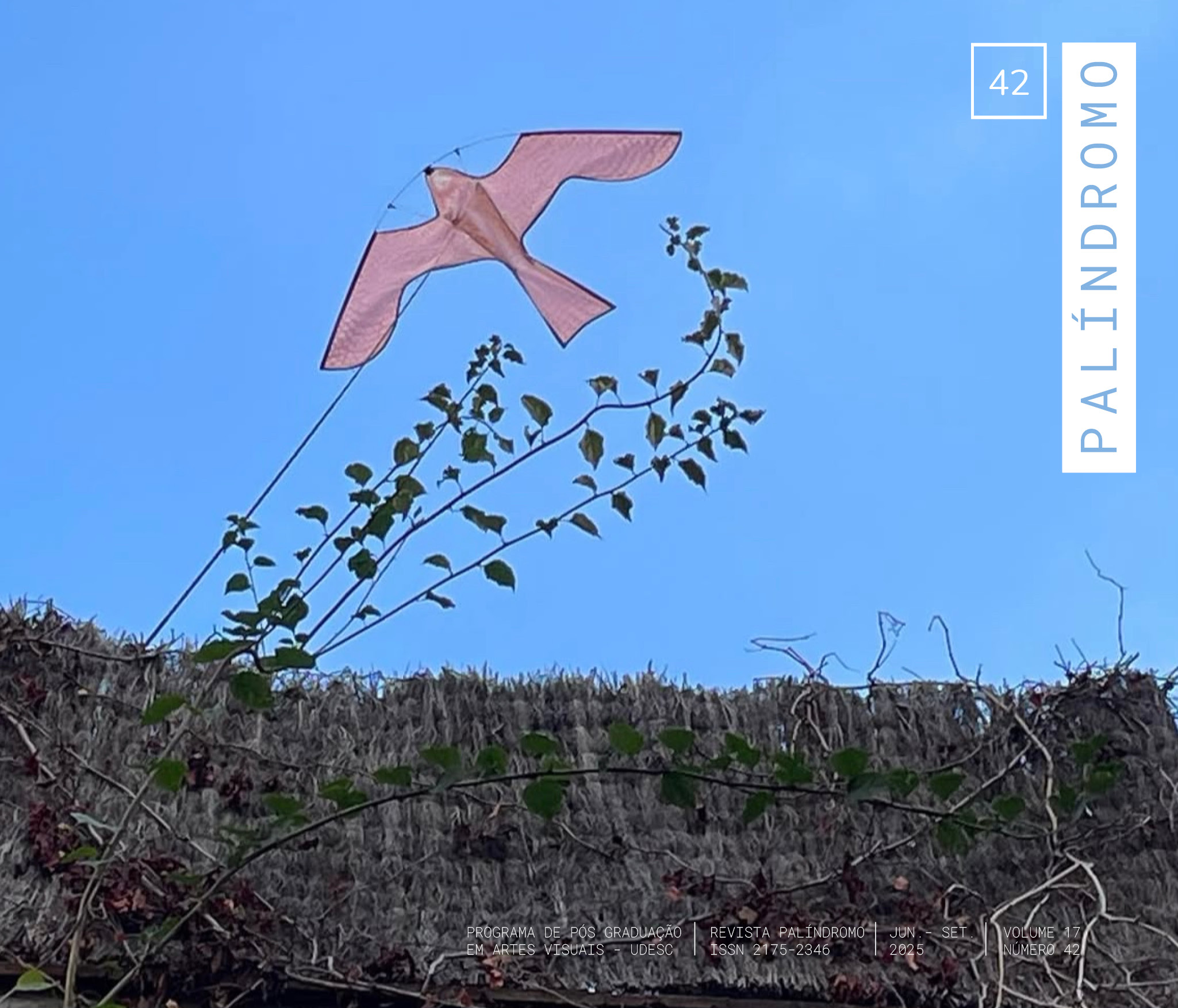Os espaços expositivos e suas contradições: possibilidades de diálogo com as escolas
DOI:
https://doi.org/10.5965/2175234617422025e0004Parole chiave:
ensino de artes, espaços expositivos, arte contemporânea, formação de professoresAbstract
A relação entre museus de arte e escolas públicas é permeada por desafios históricos: De um lado, os museus assumiram desde sua origem moderna uma função pedagógica, mas historicamente atuaram como instrumentos de legitimação de uma visão de cultura elitista e hegemônica. Por outro lado, as escolas públicas enfrentam limitações estruturais para garantir acesso sistematizado à produções artísticas. Este artigo tem como objetivo problematizar como a aproximação entre professores de arte e espaços expositivos pode ampliar o repertório estético dos estudantes, tomando como referência dados do Projeto de Pesquisa Espaços Expositivos de Arte Contemporânea, Diálogos com Ambientes Virtuais de Formação, e do Observatório de Formação de Professores no âmbito do Ensino da Arte, ambos ligados ao Centro de Artes, Moda e Design da UDESC.. A investigação, fundamentada no materialismo histórico-dialético, combinou revisão bibliográfica, análise documental e de dados do projeto, articulando: a) considerações a respeito do papel dos museus de arte como espaços didáticos, com ênfase nas disputas durante a Guerra Fria e na atuação do MASP; b) os limites e desafios enfrentados por professores de arte diante da precarização do trabalho docente e do acesso desigual a espaços culturais; c) os resultados do curso de formação em arte contemporânea oferecido no âmbito do projeto, que teve como objetivo ampliar o repertório crítico e estético de professores da educação básica. Conclui-se que a aproximação entre escolas e museus dependem de políticas públicas efetivas, infraestrutura, formação continuada e o reconhecimento da arte como direito formativo.
Downloads
Riferimenti bibliografici
ACASO, María; MEGÍAS, Clara. Art thinking: cómo el arte puede transformar la educación. Madrid: Ed. Paidós Educación, 2017.
AGAMBEN, G. Arqueologia da obra de arte. Transliteração e tradução de Vinícius Nicastro Honesko. Princípios. Revista de Filosofia. Universidade Estadual de Campinas (UNICAMP). Natal (RN): v. 20, n. 34, julho/dezembro 2013. p. 349-361.
BEMVENUTI, A. Museus e educação em museus – História, metodologias e projetos, com análises de caso: museus de arte contemporânea de São Paulo, Niterói e Rio Grande do Sul. Dissertação. Porto Alegre: UFRGS, 2004. Disponível em: <https://lume.ufrgs.br/bitstream/handle/10183/49164/000835365.pdf?sequence=1&isAllowed=y#page=2.10>. Acesso em: 16 fev. 2025.
BRENDARIOLLI, R. Das lembranças de Suzana Rodrigues. Tópicos modernos de arte e educação. 1ª. ed. Vitória: EDUFES, 2007.
CANAS, A. T. MASP: museu laboratório. Projeto de museu para a cidade, 1947-1957. Tese – Universidade de São Paulo, São Paulo: 2010. Disponível em: <https://teses.usp.br/teses/disponiveis/16/16136/tde-17062010-092757/fr.php:. Acesso em: 26 mar. 2025.
CAUQUELIN, A. Arte contemporânea, uma introdução. São Paulo: Martins Fontes, 2005.
DASARTES. O MASP se destaca na lista do Google com as instituições mais buscadas do ano. Dasartes, 12 dez. 2024. Disponível em: https://dasartes.com.br/de-arte-az/masp-se-destaca-em-lista-do-google-com-as-instituicoes-mais-buscadas-do-ano/. Acesso em: 28 mar. 2025.
FERNANDES, V. P. A formação de professores de artes visuais: impactos políticos contemporâneos. Cadernos de pesquisa em educação. Vitória - ES: PPGE/UFES, a.18, v.23, n.54, p.153, 2021.
FONSECA DA SILVA, M. C. R.; ANVERSA, Priscila. Ação educativa em espaços culturais: perspectivas sócio-históricas em debate. Cadernos CEDES. Impresso. UNICAMP: v. 42, p. 61-72, 2022.
FONSECA DA SILVA, M. C. R. Formação inclusiva para museus de Santa Catarina: um percurso de variadas possibilidades. Florianópolis: Editora da UDESC, 1. ed., v.1, 2022.
FONSECA DA SILVA, M. C. R.; GONDIM, J. P. (Orgs.). As condições de trabalho do professor de arte: um estudo do Observatório no Âmbito do Ensino de Arte. Florianópolis: Editora AAESC, 2023.
FONSECA DA SILVA, M. C. R.; OLIVEIRA, V. L.; PERINI, J. A. Professores de artes visuais e a pandemia da Covid-19. Momento – Diálogos em educação, v. 30, p. 99-122, 2021.
GRAMSCI, A. Os intelectuais e a organização da cultura. Rio de Janeiro: Civilização Brasileira, 2012.
HILLESHEIM, G. B. D. Mercado de arte e sua interface com o trabalho docente: estratégias do capitalismo cultural. Tese - Universidade do Estado de Santa Catarina, Programa de Pós-Graduação em Artes Visuais. Florianópolis, 2018. Disponível em https://sistemabu.udesc.br/pergamumweb/vinculos/000046/00004644.pdf . Acesso em 12 mar. 2025.
LUKÁCS, G. Estética: a peculiaridade do estético. São Paulo: Ed. Boitempo, vol.1, 2023.
MASP. Relatório anual de atividades MASP 2023. Museu de Arte de São Paulo Assis Chateaubriand, São Paulo: 2024. Disponível em https://assets.masp.org.br/uploads/about-governance-items/Kt7DXsUv3CGjwQduMn53dX219fvs6OOK.pdf#page=48.08 . Acesso em: 19 mar. 2025
OLIVEIRA, V. L. Arte e formação humana? Limites do ensino de arte em contexto de expropriação docente. In: FONSECA DA SILVA, M. C. R.; GONDIM, J. P. (Orgs.). As condições de trabalho do professor de arte: um estudo do Observatório no Âmbito do Ensino de Arte. Florianópolis: Editora AAESC, 2023. p. 152-164.
PISANI, D. O trianon do MAM ao MASP: arquitetura e política em São Paulo (1946-1968). São Paulo: Ed.34, 2019.
RIDENTI, M. O segredo das senhoras americanas: intelectuais, internacionalização e financiamento na Guerra Fria cultural. São Paulo: Editora Unesp, 2022.
SILVA, M. H. G.; ALAMBERT JUNIOR, F. C. A política externa estadunidense e os museus de arte moderna de São Paulo. In: ASSUMPÇÃO, A. L. et al. Patrimônios e imaginários. São Carlos: IAU/USP, 2024. Disponível em: https://ppgsa.s3.sa-east-1.amazonaws.com/61474a2b0867bc7f3a95d2610cccda42.pdf#page=239. Acesso em: 15 fev. 2025.
Downloads
Pubblicato
Come citare
Fascicolo
Sezione
Licenza
Copyright (c) 2025 Maria Cristina Silva, Janaina Enck, Micheline Barros

TQuesto lavoro è fornito con la licenza Creative Commons Attribuzione 4.0 Internazionale.
DECLARAÇÃO DE DIREITOS AUTORAIS
a. Os artigos publicados pela revista são de uso gratuito, destinados a aplicações acadêmicas e não comerciais. Todos os direitos autorais são atribuídos à revista. Os artigos cujos autores são identificados representam a expressão do ponto de vista de seus autores e não a posição oficial da Revista Palíndromo. O (s) autor (es) compromete-se sempre que publicar material referente ao artigo publicado no Palíndromo mencionar esta publicação da seguinte forma:
Este artigo foi publicado originalmente pela revista Palíndromo em seu volume (coloque o volume), número (coloque o número) no ano de (coloque o ano) e pode ser acessado em: http://www.revistas.udesc.br/index.php/palindromo
b. Plágio, em todas as suas formas, constitui um comportamento antiético de publicação e é inaceitável. A revista Palíndromo utiliza o software iThenticate de controle de similaridade


